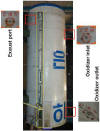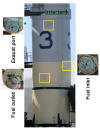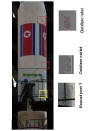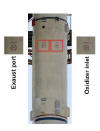|
2012, Dec. 14 -- South Korea's Navy has retrieved debris of North Korea's
Unha-3 rocket. The 3.2-ton upper part of the first stage (oxidizer tank),
which was inscribed with the rocket's name "Unha," is 7.6 meter long.
|

|

|

|

Lower part of the tank
|

Upper part of the tank
|

|

|
|

|

Diameter
|

Length
|

Oxidizer drain
|

Interior view |
|
Welds and the original green
paint of the rocket
|
Captured
oxidizer-tank of Unha-3 first stage
2012,
Dec. 23 -- After examining the 3.2-ton wreckage a team of 42 South Korean
military, rocket and missile experts has concluded that the wreckage is an
oxidizer container,
which stored red fuming nitric acid*,to
fuel the rocket's first-stage propellant. The storable oxidizer that contains
highly toxic chemicals is rarely used by countries with advanced space technology,
the defense ministry said, quoting the team's findings. The tank storing about
48 (?) tons of oxidizer. The rocket itself was made of a mixture of aluminum
and magnesium, AIMg6, and was equipped with a camera tasked with monitoring
engines, a propellant motor and fuel pipelines on its side.
* Is this statement truth or just propaganda
? The tank was filled with seawater !
2012, Dec. 23 -- South Korea's Navy has retrieved three more pieces
-- a fuel tank, its combustion chamber and an engine connection rod -- from
the lower part of the Unha-3 first stage in the Yellow Sea.
2012, Dec. 28 -- South Korea has retrieved half a dozen items of
debris from North Korea's Unha-3 rocket engines.
Captured
fuel-tank and engines of Unha-3 first stage
2013, January 02
Debris analysis: ucsusa.org & ucsusa.org (translation)
|

|

|

|

|
|
First stage: Oxidizer tank
|
First stage: Fuel tank
|
Second stage
|
Third stage
|
|

Steering engine in action
|
Note: The first
stage was steered not by jet vanes. Instead the analysis states the Unha
first stage uses four small “auxiliary engines".
These small engines, not comparable with the steering
engines from the Soviet R-27 SLBM, are possibly working in pressure-fed
mode. Belonging extra-tanks were found in the debris (above). These
tanks are missing in the Iranian Simorgh, because the steering engines
are different, have their own turbopump and are supplied by the main tanks.
|

|

|

|

|
|
Unha first stage steering
engines
|
|
|